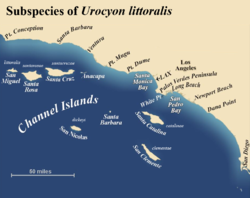| Urocyon [1] Temporal range: [2] | |
|---|---|
 | |
| Gray and island fox | |
| Scientific classification | |
| Kingdom: | Animalia |
| Phylum: | Chordata |
| Class: | Mammalia |
| Order: | Carnivora |
| Family: | Canidae |
| Subfamily: | Caninae |
| Tribe: | Urocyonini |
| Genus: | Urocyon Baird, 1857 [3] |
| Type species | |
| Canis virginianus [4] | |
| Species | |
| |
Urocyon (Greek: "tailed dog" [7] ) is a genus of Canidae which includes the gray fox (Urocyon cinereoargenteus) and the island fox (Urocyon littoralis). [1] These two fox species are found in the Western Hemisphere. Whole genome sequencing indicates that, among living canids, Urocyon is sister to the remaining genera. [8] Fossils of what is believed to be the ancestor of the gray fox, Urocyon progressus , have been found in Kansas and date to the Upper Pliocene, [9] with some undescribed specimens dating even older. [10]














